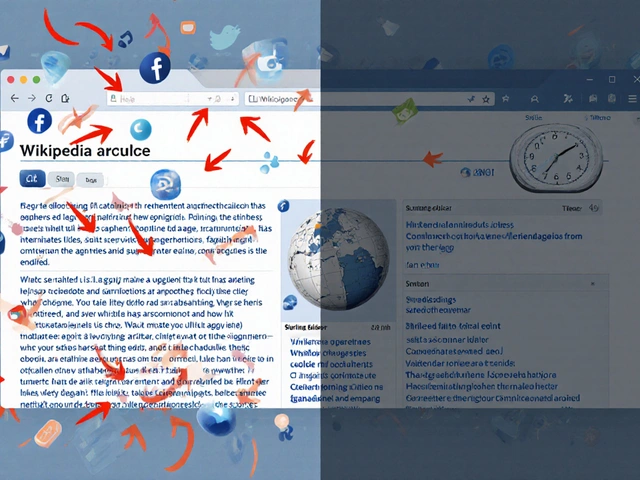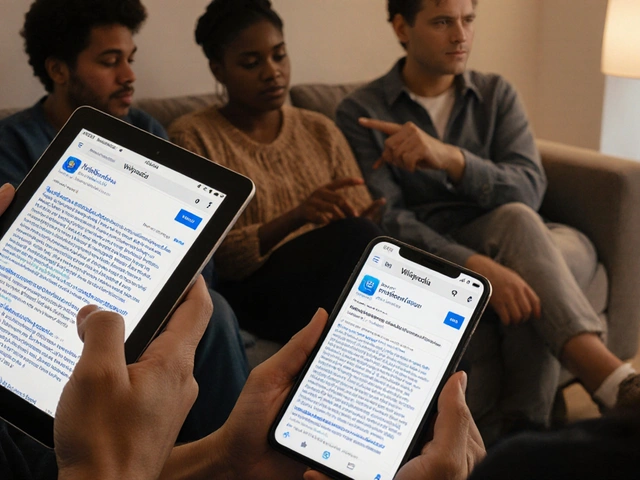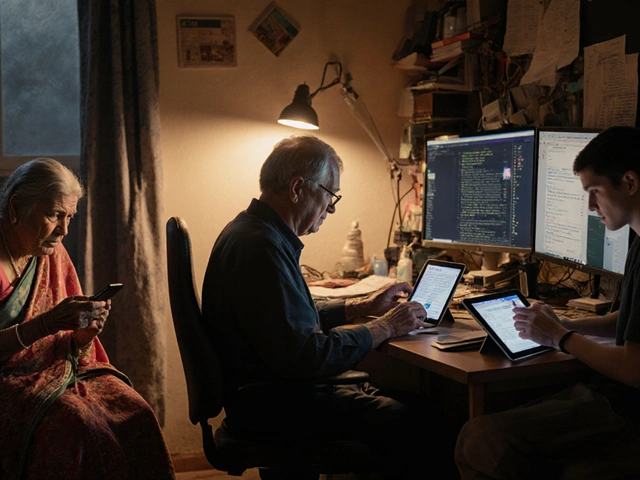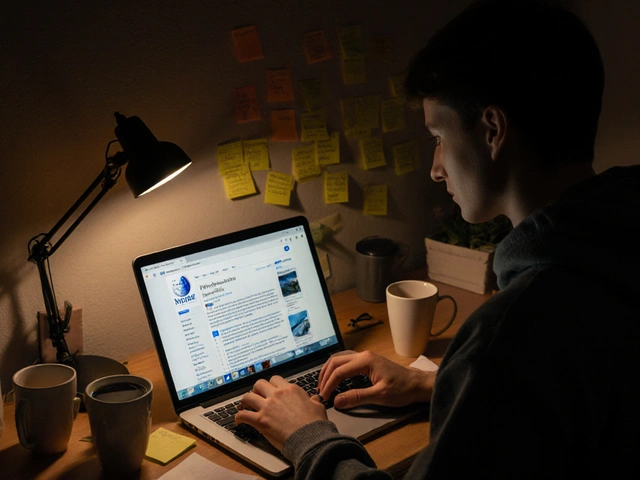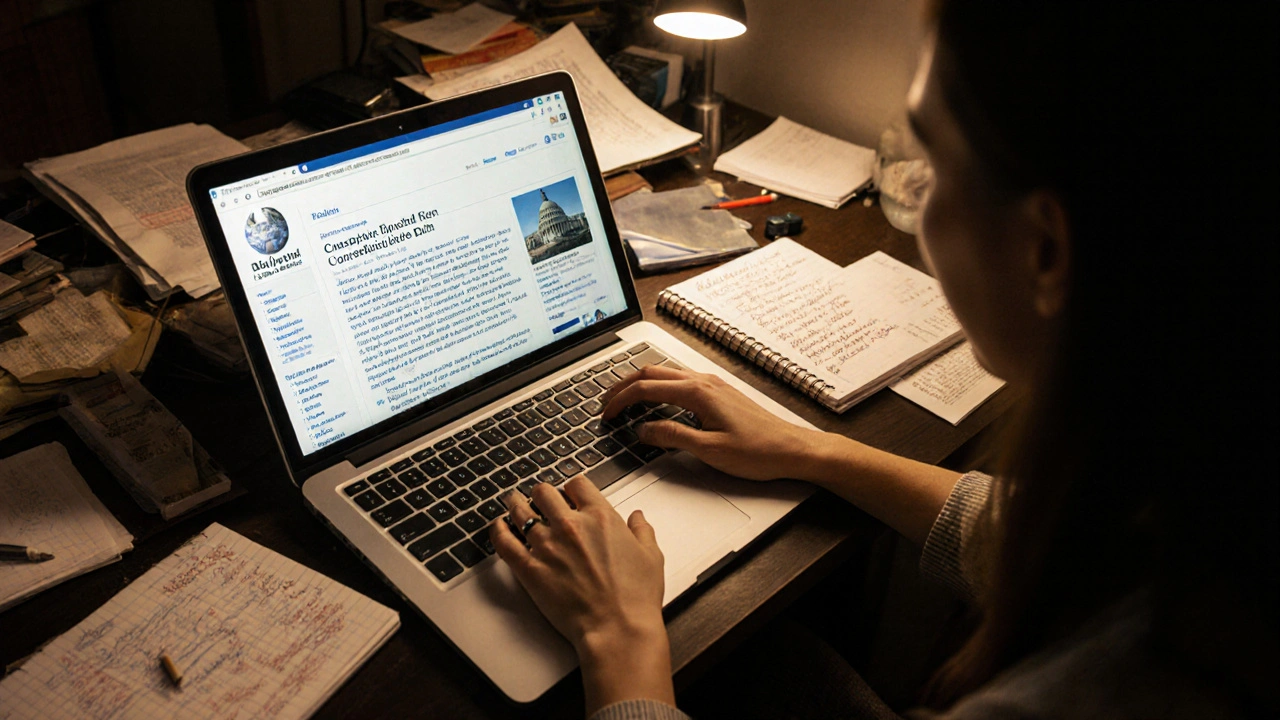
Wikipedia isn’t a source. But it’s one of the first places most journalists go when they’re starting a story. And that’s not wrong-just incomplete. If you treat Wikipedia like a library’s index card system, you’ll save hours, avoid dead ends, and find real leads faster than you would by typing the same search into Google.
Why journalists use Wikipedia (and why it’s not the end of the road)
You’re covering a new bill in Congress. You’ve never heard of the sponsor. You open Wikipedia. There it is: a short bio, party affiliation, committee assignments, major votes, and a list of sources at the bottom. That’s not magic. That’s crowdsourced curation. Someone spent hours compiling this from official government records, news archives, and academic papers. You didn’t have to dig through 17 PDFs to get there.
Wikipedia’s real value isn’t in quoting it. It’s in discovery. It’s the fastest way to map out the landscape of a topic before you start interviewing people. Think of it as a pre-interview checklist. Who are the key players? What are the major events? What terms do experts use? What controversies have already been reported?
One reporter covering a local school board dispute found a Wikipedia page on the district’s history. The page listed three former superintendents, two major lawsuits, and a 2018 audit report. She called the audit author. That call led to a three-part series on financial mismanagement that won a state journalism award. She didn’t cite Wikipedia. She cited the audit. But Wikipedia showed her where to look.
How to read a Wikipedia page like a journalist
Not all Wikipedia pages are created equal. Some are well-maintained. Others are messy, outdated, or even manipulated. Here’s how to tell the difference:
- Check the edit history. Click “View history.” If the page has been edited daily by a mix of anonymous users and registered accounts, it’s likely active and monitored. If it hasn’t been touched in two years, proceed with caution.
- Read the talk page. Scroll down to “Talk.” This is where editors argue over content. If there’s a heated debate about a fact, that’s your red flag. If editors cite reliable sources to back up claims, that’s your green light.
- Look at the references. Scroll to the bottom. Are the citations from newspapers, academic journals, government reports, or books? Or are they blogs, personal websites, or self-published material? Prioritize the former. If a claim has no citation at all, treat it as unverified.
- Check the quality rating. At the top of the page, you might see “Good Article” or “Featured Article.” These are vetted by Wikipedia editors and tend to be more reliable. Not all pages have this, but when they do, it’s a strong signal.
Don’t skip the talk page. I once found a claim about a politician’s voting record that was flagged by three editors as “unverifiable.” I followed the link to the official legislative database. The Wikipedia claim was wrong. I corrected it. Then I used the corrected version to contact the politician’s office for comment. That correction became the lead in my story.
How to trace a Wikipedia reference back to the original
Wikipedia is a middleman. Your job is to find the source behind the source. Here’s how:
- If the citation is a newspaper article, search the newspaper’s website or use LexisNexis, ProQuest, or Google News Archive.
- If it’s a government report, search the official agency site. Use site:gov or site:edu in your search to filter results.
- If it’s a book, check WorldCat or your local library’s catalog. Many universities offer free digital access.
- If it’s a journal article, use Google Scholar. Type the title in quotes. If it’s behind a paywall, email the author. Most academics will send you a copy.
One time, a Wikipedia entry on a defunct tech startup cited a “2018 TechCrunch article.” I searched TechCrunch’s site. No article. I checked the Wayback Machine. Found it-archived in 2019, but the original had been taken down after a legal threat. The story was incomplete. I reached out to the startup’s former CFO. He gave me the full context. That became my exclusive.
Wikipedia doesn’t give you the story. It gives you the breadcrumbs. Follow them.

What to avoid: common pitfalls for journalists
Wikipedia is full of traps. Here are the ones most journalists fall into:
- Quoting Wikipedia directly. Never write “According to Wikipedia…” in your article. It undermines your credibility. Even if the fact is true, it looks lazy. Always trace it.
- Believing the headline. Wikipedia titles are often simplified. A page titled “Climate Change Denial in the U.S.” might focus on a single activist group. That’s not the full picture. Read the whole page.
- Assuming accuracy because it’s popular. The page on “The 2020 Election” has over 100,000 edits. That doesn’t mean every detail is correct. Some edits are partisan. Some are bots. Always verify.
- Ignoring the “See also” section. This is gold. If you’re writing about a whistleblower, the “See also” might link to related scandals, investigative bodies, or legal precedents you didn’t know existed.
One journalist covering a local corruption case found a Wikipedia page on a nonprofit. The “See also” section listed a state ethics commission. She didn’t know that commission existed. She filed a public records request. It uncovered emails proving the nonprofit had been used to funnel campaign donations. That’s the kind of lead Wikipedia can give you-if you’re paying attention.
When Wikipedia fails you
Not every topic has a good Wikipedia page. Small towns, niche industries, or recent events often have incomplete or missing entries. That’s normal.
If you can’t find a Wikipedia page, that’s not a dead end. It’s a signal. No page means no one has compiled the information yet. That’s your opportunity. You might be one of the first to document it.
For example, a reporter in rural Kansas couldn’t find a Wikipedia page on a local wind farm project. She started from scratch: contacted the company, found the county planning documents, interviewed residents, and wrote the first detailed account. Later, someone else used her article to build the Wikipedia page. That’s how journalism and Wikipedia work together.

How to contribute back
Wikipedia thrives on contributions. If you find a page that’s missing key facts, fix it. If you see a citation that’s broken, update it. If you’re an expert on a topic, add your knowledge.
Journalists have a unique advantage: access to primary sources. If you interview a scientist, and they mention a study that’s not cited on Wikipedia, add it. If you file a FOIA request and get documents that clarify a public figure’s history, update the page with the citation.
Don’t edit anonymously. Create a free account. Use your real name or a professional pseudonym. When you edit, write a clear summary: “Added citation to 2024 EPA report on emissions.” That builds trust. And if your edit gets reverted? That’s okay. It means someone else is watching. You can discuss it on the talk page.
Contributing isn’t charity. It’s professional hygiene. You’re helping other journalists find better information faster. And you’re building a public record that’s more accurate because of your work.
Wikipedia isn’t your source. It’s your starting line.
Journalism isn’t about quoting the internet. It’s about finding truth through verification. Wikipedia doesn’t replace that. It accelerates it. The best journalists don’t avoid Wikipedia. They use it like a compass-pointing them toward the real sources, the real people, the real stories.
Next time you start a story, open Wikipedia. Don’t copy. Don’t quote. Don’t stop there. Use it to ask better questions. To find better sources. To write better stories.
Can I cite Wikipedia in my news article?
No. Citing Wikipedia directly makes your reporting look unprofessional and unverified. Always trace the claim back to its original source-a government report, news article, academic paper, or official document-and cite that instead. Wikipedia is a tool for discovery, not a source for attribution.
Is Wikipedia reliable for breaking news?
Generally, no. Breaking news pages on Wikipedia are often edited rapidly by non-experts and may contain rumors, speculation, or errors. Wait for established news outlets to report the event first. Then use Wikipedia to understand context, background, and related figures-but never as your primary source for new developments.
How do I know if a Wikipedia page is well-maintained?
Check the edit history for recent, frequent edits by multiple users. Look for a “Good Article” or “Featured Article” label at the top. Read the talk page for signs of active discussion and source-based debates. Pages with many citations from reputable sources and few disputes are more trustworthy.
What should I do if Wikipedia has incorrect information?
If you know the information is wrong, correct it. Create a Wikipedia account, edit the page with a clear edit summary, and cite your source. If your edit is reverted, engage in the talk page discussion. Journalists who contribute accurate, sourced information help improve the quality of public knowledge.
Can I use Wikipedia to find experts to interview?
Yes. Wikipedia pages often list key figures, institutions, or organizations related to a topic. Look at the “See also” section, references, and external links. These can lead you to researchers, government officials, or advocates who are credible sources. Always verify their credentials independently before contacting them.



